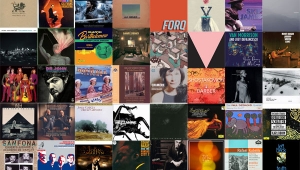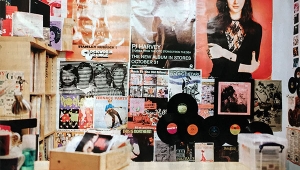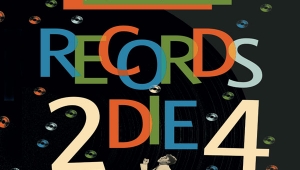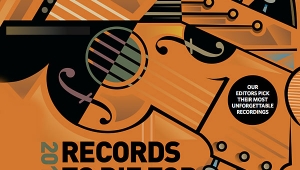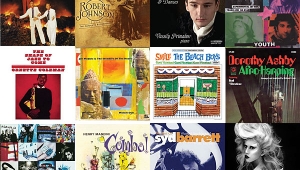| Columns Retired Columns & Blogs |
2003 Records To Die For Page 2
John Atkinson
J.S. BACH: Goldberg Variations
Murray Perahia, piano
Sony Classical SK 89243 (CD) SS 89243 (SACD). 2000. Andreas Neubronner, prod.; Markus Heiland, eng.; Andrew Grainger, asst eng.; Matthew Cocker, ed.; Jen Wyler, DSD authoring eng. DDD. TT: 73:28
With all the fuss that is currently and justifiably being made about the late Glenn Gould's two historically important readings of the Goldberg Variations—it was Gould who rescued the work from the museum—it is easy to forget that other pianists can breathe life into them. Since his recovery from a hand injury, Murray Perahia has been exploring Bach's keyboard works, to critical and commercial acclaim. No, this set of 30 imaginative variations on the "Fundamental Bass" of the Aria that bookends them was not written for the piano, but Perahia's delicacy of touch, subtle use of dynamic shadings, clarity of line in the canons and Fughetta, and effortless virtuosity demonstrate that the anachronistic instrument doesn't have to overpower the music within the notes. The sound is close, with the sound of Perahia's fingernails on the Steinway's keys occasionally clatteringly clear, but the music is not the worse for it. The SACD, which appears to be mastered from a 24-bit original, sounds simply better.
J.S. BACH: Six Keyboard Partitas, BWV 825-830
Trevor Pinnock, harpsichord
Hänssler Edition Bachakademie 92.115 (2 CDs). 2000. Michele Gaggia, recording supervisor. DDD. TT: 2:29:04
We all have skeletons in our closets. One of mine is that it was in 1963 that the Swingle Singers' arrangement of the Sinfonia from the second of Bach's keyboard Partitas (CD reissue, Philips 824 703-2) simultaneously turned me on to Bach and had me wishing my parent's stereo console could produce better sound. Majestic minor-key chords lead into a swinging, twisting, climbing vocal line that is supported by a walking bass line (footnote 1) from double bassist Pierre Michelot. This sounds so much like the small-group jazz that I was also then becoming aware of that it came as a surprise to learn, when I looked at the score, that every note (other than some necessary octave substitutions in the bass) was as Bach had written 250 years earlier.
Footnote 1: Like many of Bach's bass lines, this one is a joy to play, which is why I persuaded Bob Reina that we should open our set at Home Entertainment 2001 with a transcription of the Sinfonia for Hammond organ and Fender bass.—John Atkinson
LOUIS ARMSTRONG: Satch Plays Fats
Columbia/Legacy CK 64927 (CD). 1955/2000. George Avakian, Tommy Rockwell, orig. prods.; Avakian, Nedra Olds-Neal, reissue prods; Mark Wilder, mastering; John T. Davies, transfers of 1929-30 material. AAD/A-D. TT: 78:57
In this latest reissue of one of the two albums generally thought to be Armstrong's last genuinely great records (the companion being ...Plays W.C. Handy), a variety of older recordings of the trumpeter doing the same material are included for perspective. While that's nice, the original 1955 record, not the inferior outtakes that filled a botched 1985 reissue also titled Satch Plays Fats, is still a dark, rich jewel—perhaps the finest melding of Armstrong's singing and playing ever captured on disc. His affinity for Waller's material is otherworldly, making his takes on such tunes as "(What Did I Do to Be So) Black and Blue," and particularly "Ain't Misbehavin'," almost definitive. Driven by trombonist Trummy Young, the breakneck tempo on "Misbehavin'," which forces Armstrong to run verses together into jabberwocky, never fails to make me smile.
RY COODER: Paradise and Lunch
Reprise 2179-2 (CD). 1974. Lenny Waronker, Russ Titelman, prods.; Lee Herschberg, eng. Bobby Hata, John Neal, asst. engs. AAD. TT: 37:24
The kind of record that would never be made today by any major record label, Cooder's 1974 masterpiece was the one time this heretofore sideman (from the Rolling Stones to Captain Beefheart), whose solo career on record had been variable, finally aligned the planets and cut a knockout album. Aided by ace players like drummer Jim Keltner and bassists Russ Titelman and Chris Etheridge, not to mention guest appearances by tenor sax player Plas Johnson (best known for the theme to The Pink Panther) and the great Earl "Fatha" Hines on piano, Cooder's distinctive guitar work leads a session of only highlights. All songs here meet at the crossroads of gospel, blues, folk, and country collectively known as American roots music. At the album's heart are two of the choicest moments from Cooder's solo career: the traditional call-and-response gospel classic "Jesus on the Mainline," and Bobby Womack's r&b standard "It's All Over Now." While his soundtrack work is fine, this remains the reticent guitarist's magnum opus—so far.
TOUS LES MATINS DU MONDE: Original Soundtrack
Jordi Savall, dir., viola da gamba; Christophe Coin, viola da gamba; Montserrat Figueras, Maria Cristina Kiehr, sopranos; Fabio Biondi, violin; Pierre Hantaï, harpsichord; Rolf Lislevand, theorbo; Les Concert des Nations
Alia Vox 9821 (CD). 1991/2001. Pierre Verany, prod.; André Pierrette, eng.; Jiri Heger, Nicolas Bartholomée, remastering. ADD. TT: 76:00
The 1991 Alain Corneau film of Pascal Quignard's novella Tous les Matins du Monde is rare in that it improves on the original: the film is deeper, richer than the book. Even more uncommon is the soundtrack, which still resonates a decade later in this beautifully remastered and repackaged anniversary edition. Catalan viola da gamba master Jordi Savall ideally evokes the French Grand Siécle, in particular the music of Marin Marais and the shadowy Sainte-Colombe—whose problematic relationship is the story's dramatic crux. Along with playing intimately expressive viola da gamba, Savall directs such scores as Couperin's Leçon de Ténèbres. Refracted through the prism of Savall's sensitive virtuosity, this is soul music for the ages. (XVI-5)
VASSILIS TSABROPOULOS/ARILD ANDERSEN/JOHN MARSHALL: Achirana
Vassilis Tsabropoulos, piano; Arild Andersen, bass; John Marshall, drums
ECM 1728 (CD). 2000. Manfred Eicher, prod.; Jan Erik Kongshaug, eng. DDD. TT: 69:45
If Keith Jarrett's name were on this album, critics would hail it as a classic. The disc is a classic, but it's by a pianist most listeners have probably never heard of: 36-year-old Vallis Tsabropoulos. Known more as a classical interpreter in his native Greece, Tsabropoulos came as a composer-improviser came to ECM's attention via veteran Norwegian bassist Arild Andersen. Their trio with English drummer John Marshall is seemingly telepathic, with the virile rhythm section framing perfectly the pianist's glimmering, cliché-free lyricism. The remarkably detailed production—this is one of the best-sounding piano-trio records you'll ever hear—makes Achirana all that much more hypnotic.
J.S. BACH: Suites for Solo Cello
Mstislav Rostropovich, cello
EMI Classics 5 55364 26/27 (2 CDs). 1995. Guy Chesnais, prod.; Raymond Buttin, eng. DDD. TT: 2:27:54
The sound on the EMI Rostropovich discs is not of the highest order, but the playing is so far superior to anyone else's that I have to add it to the roster of Records For Which I Might Conceivably Discorporate. There are fine early-instrument performances available, as well as a long list of modern renditions going back to the age of 78s (Casals). None is a match for this set. Every note, every phrase sounds new-minted, as if being discovered for the first time. My only regret is that I did not add these to my list the moment they were issued. (XVIII-10)
BIG YOUTH: Screaming Target
Trojan TRL 61 (CD). 1973/1995. Gussie Clarke, prod.; Errol Thompson, Karl Pitterson, Syd Bucknor, engs. AAD? TT: 38:26
Big Youth, aka Manley Buchanan, brought a Rastafarian perspective to the original dancehall-reggae concept pioneered by deejay U-Roy. This 1973 debut LP, brilliantly produced by the 20-year-old Gussie Clarke, set the standard for Jamaican dancehall in the '70s and paved the way for the American hip-hop movement that followed.
ALBERT KING: Born Under a Bad Sign
Stax SCD-8606-2 (CD). 1967/2002. George Horn, remastering. AAD? TT: 34:30
Though Albert King had already scored hit R&B singles, this 1967 release crossed him over into the album-oriented blues market and onto the psychedelic ballroom circuit, right alongside B.B. King. A classic Stax production, Born Under a Bad Sign features Booker T. and the MG's as well as the Memphis Horns, who were, typically, not credited on the original LP. That oversight was corrected on last year's long-overdue CD reissue, which also brings the vintage hot-and-dirty mix into sharper focus.
FUTURE SOUND OF LONDON: Papua New Guinea Translations
Jumpin' and Pumpin' CD TOT52 (UK CD). 2001. Garry Cobain, Brian Dougans, prods., mix; Yage, Stone Freshwaters, engs. A?DD. TT: 54:25
Future Sound of London has always been at the furthest edge of England's New Psychedelia and ambient/trance genres, but Papua New Guinea Translations pushes that edge into an alternate universe. Dougans and Cobain offer their 1991 UK hit single, "Papua New Guinea," and seven "translations" thereof, to take the listener on a mind-blowing cosmic journey. Hey, if the theme-and-variations format was good enough for Elgar, Brahms, and Rachmaninoff, why not for today's premier purveyors of electronic music?
VAUGHAN WILLIAMS: Orchestral Music
Fantasia on a Theme by Thomas Tallis, Fantasia on "Greensleeves", The Lark Ascending, Five Variants of "Dives and Lazarus"
Neville Marriner, Academy of St. Martin-in-the-Fields
Argo ZRG 696 (LP). 1972. Michael Bremner, prod.; Stanley Goodall, eng. AAA.
For my money, this LP holds some of the most gorgeous music of the 20th century, played with thorough understanding and absolute conviction. This record is about beauty, pure and simple, and my love of the music of Vaughan Williams began with this wonderful LP. Other recordings of these works possess great distinction in their own rights, but Marriner and the ASMF have never been bettered. The final Variant and concluding recapitulation of Dives and Lazarus have been, for years, one of my acid tests for components. On a good enough system, they can move me to tears. And I've yet to hear a finer Lark. Just a bit of overdriven ragginess on a couple of the larger crescendos keeps the sound from being great. Apart from that, engineer Stanley Goodall captured a warm, luscious sound that perfectly serves the works. Essential.
GOLIJOV: La Pasión Según San Marcos
Luciana Souza, Samia Ibrahím, Reynaldo Gonzáles Fernández, vocalists; Schola Cantorum de Carácas, Cantoría Alberto Grau, Orquesta La Pasión; Maria Guinand, conductor
Hännsler Classic 98.404 (2 CDs). 2000. Andreas Priemer, prod.; Karl-Heinz Runde, eng. DDD. TT: 85:38
Up front, I'm a lapsed Catholic with serious aversions to most things religious. It took an Argentine Jew—Osvaldo Golijov—to move my soul with a sacred work of power and originality. Commissioned for the 250th anniversary of J.S. Bach's birthday, Golijov's La Pasión Según San Marcos is a pan-Latin American work scored for a mix of standard classical instruments augmented by Cuban, Brazilian, and Native American percussion, accordion, and guitar, with a full choir and, on this recording, exceptional soloists. The work succeeds in harnessing both the honest power of a broad range of traditional musics and the harmonic and structural sophistication of the classical sphere to speak to the profound and sincere Christian faith so many in the Hispanic Americas hold. A musically gripping experience performed with passion and stylistic nuance.
THE WHO: Who's Next
MCA 37217 (CD). 1971/1984. The Who, prods.; Glyn Johns, prod., eng. AAD. TT: 43:13
I remember driving back to Tucson with my college buddies in a freak snowstorm after seeing the Who perform Who's Next in Phoenix. There were no guardrails, so we determined where to drive by how far the cactus should be from the invisible road. It was the early '70s. Yet despite the fact that the snow was coming down so blindingly hard that we could barely see past the hood of the car, and might at any point have gotten our stoned asses into a desert wreck, all we could talk about was the music. Every tune on that album, from "Baba O'Riley" to "The Song is Over," "Behind Blue Eyes," and "Won't Get Fooled Again," got us stoked. Thirty-some years later, it still stands up, and remains one of the 10 discs I've carried with me on every long-distance driving trip I've taken since then. It's probably been responsible for half of my speeding tickets. (XVII-2, XVIII-12, XXII-12)
THE GO-BETWEENS: Spring Hill Fair
Circus/Jetset 48 (2 CDs). 1984/2002. Colin Fairley, John Brand, prods., engs.; Robert Andrews, prod.; Jacques Hermet, eng. AAD? TT: 40:29
The third effort from Australia's masters of the pop ache is slicker and less emblematic than its predecessor, Before Hollywood. But when I first discovered the Go-Bs on a 1985 best-of, the songs that won me over came from this one, which distills the quirky lushness of Prefab Sprout with both acoustic strum and wiry riffing (hence the band's initial association with the Postcard and Rough Trade labels). Robert Forster's "Man O' Sand to Girl O' Sea" (an indie-rock epic) and "Draining the Pool for You" ("Take This Job and Shove It" as if written by Warren Zevon and played by the Smiths) are highlights, but the record's heart lies in the longing and regret of Forster's "Part Company" and Grant McLennan's beauteous "Bachelor Kisses." The Jetset reissue is a two-disc set with 10 bonus tracks and one video.
JOHN HIATT: Slow Turning
A&M CD 5206 DX 003683 (CD). 1988. Glyn Johns, prod.; Larry Hirsch, eng. AAD. TT: 49:04
John Hiatt's craft is to write the same kind of songs as everybody else. His art is that he gets away with it. As a 20-year-old college student, I had no particular need to hear the Elvis Costello of Tennessee ruminate on marriage, and 15 years later, I still don't need to hear another outlaw-couple road song. But I never tire of Slow Turning. The successor to Hiatt's Bring the Family arrived without Nick Lowe, Ry Cooder, and Jim Keltner, and with heightened expectations, but musically it's no less striking, thanks to Sonny Landreth and the Goners and Bernie Leadon's added twang. The songs are lovely ("Feels Like Rain"), wise ("Sometime Other than Now"), and frequently hilarious. "Georgia Rae"—the sweetest, most lascivious, least mawkish tribute to a newborn ever—manages all three. And "Tennessee Plates" does more for lovestruck bandits in seven stanzas than anyone since Arthur Penn. (XI-11, XVI-2, XXII-6)
J.S. BACH: Goldberg Variations
Murray Perahia, piano
Sony Classical SK 89243 (CD) SS 89243 (SACD). 2000. Andreas Neubronner, prod.; Markus Heiland, eng.; Andrew Grainger, asst eng.; Matthew Cocker, ed.; Jen Wyler, DSD authoring eng. DDD. TT: 73:28
With all the fuss that is currently and justifiably being made about the late Glenn Gould's two historically important readings of the Goldberg Variations—it was Gould who rescued the work from the museum—it is easy to forget that other pianists can breathe life into them. Since his recovery from a hand injury, Murray Perahia has been exploring Bach's keyboard works, to critical and commercial acclaim. No, this set of 30 imaginative variations on the "Fundamental Bass" of the Aria that bookends them was not written for the piano, but Perahia's delicacy of touch, subtle use of dynamic shadings, clarity of line in the canons and Fughetta, and effortless virtuosity demonstrate that the anachronistic instrument doesn't have to overpower the music within the notes. The sound is close, with the sound of Perahia's fingernails on the Steinway's keys occasionally clatteringly clear, but the music is not the worse for it. The SACD, which appears to be mastered from a 24-bit original, sounds simply better.
J.S. BACH: Six Keyboard Partitas, BWV 825-830
Trevor Pinnock, harpsichord
Hänssler Edition Bachakademie 92.115 (2 CDs). 2000. Michele Gaggia, recording supervisor. DDD. TT: 2:29:04
We all have skeletons in our closets. One of mine is that it was in 1963 that the Swingle Singers' arrangement of the Sinfonia from the second of Bach's keyboard Partitas (CD reissue, Philips 824 703-2) simultaneously turned me on to Bach and had me wishing my parent's stereo console could produce better sound. Majestic minor-key chords lead into a swinging, twisting, climbing vocal line that is supported by a walking bass line (footnote 1) from double bassist Pierre Michelot. This sounds so much like the small-group jazz that I was also then becoming aware of that it came as a surprise to learn, when I looked at the score, that every note (other than some necessary octave substitutions in the bass) was as Bach had written 250 years earlier.
Since that formative experience, I've been looking for a recording of the work that captures the sense of unfettered musicmaking embodied in these six sets of short works. This recent album from English early-music champion Trevor Pinnock does so in spades. This is not dry, academic score-reading, but spirited musicmaking that reminds you that no matter how complex the web woven by the musical development, every movement still stems from the dance. The recorded sound is also excellent. If you speak while touching the case of a good harpsichord, you can feel it tremble, as if it were eager to sing. The sound of this set captures that feeling, being rich, warm, and resonant, without emphasizing the plucked attacks of the instrument (a 1983 re-creation by David Way of a Hemsch original). The occasional low bass notes have delicious weight, without booming, and when Pinnock uses a damped stop, the cascading notes illuminate the recording space in a most pleasing manner.
Footnote 1: Like many of Bach's bass lines, this one is a joy to play, which is why I persuaded Bob Reina that we should open our set at Home Entertainment 2001 with a transcription of the Sinfonia for Hammond organ and Fender bass.—John Atkinson
Robert Baird
LOUIS ARMSTRONG: Satch Plays Fats
Columbia/Legacy CK 64927 (CD). 1955/2000. George Avakian, Tommy Rockwell, orig. prods.; Avakian, Nedra Olds-Neal, reissue prods; Mark Wilder, mastering; John T. Davies, transfers of 1929-30 material. AAD/A-D. TT: 78:57
In this latest reissue of one of the two albums generally thought to be Armstrong's last genuinely great records (the companion being ...Plays W.C. Handy), a variety of older recordings of the trumpeter doing the same material are included for perspective. While that's nice, the original 1955 record, not the inferior outtakes that filled a botched 1985 reissue also titled Satch Plays Fats, is still a dark, rich jewel—perhaps the finest melding of Armstrong's singing and playing ever captured on disc. His affinity for Waller's material is otherworldly, making his takes on such tunes as "(What Did I Do to Be So) Black and Blue," and particularly "Ain't Misbehavin'," almost definitive. Driven by trombonist Trummy Young, the breakneck tempo on "Misbehavin'," which forces Armstrong to run verses together into jabberwocky, never fails to make me smile.
RY COODER: Paradise and Lunch
Reprise 2179-2 (CD). 1974. Lenny Waronker, Russ Titelman, prods.; Lee Herschberg, eng. Bobby Hata, John Neal, asst. engs. AAD. TT: 37:24
The kind of record that would never be made today by any major record label, Cooder's 1974 masterpiece was the one time this heretofore sideman (from the Rolling Stones to Captain Beefheart), whose solo career on record had been variable, finally aligned the planets and cut a knockout album. Aided by ace players like drummer Jim Keltner and bassists Russ Titelman and Chris Etheridge, not to mention guest appearances by tenor sax player Plas Johnson (best known for the theme to The Pink Panther) and the great Earl "Fatha" Hines on piano, Cooder's distinctive guitar work leads a session of only highlights. All songs here meet at the crossroads of gospel, blues, folk, and country collectively known as American roots music. At the album's heart are two of the choicest moments from Cooder's solo career: the traditional call-and-response gospel classic "Jesus on the Mainline," and Bobby Womack's r&b standard "It's All Over Now." While his soundtrack work is fine, this remains the reticent guitarist's magnum opus—so far.
Bradley Bambarger
TOUS LES MATINS DU MONDE: Original Soundtrack
Jordi Savall, dir., viola da gamba; Christophe Coin, viola da gamba; Montserrat Figueras, Maria Cristina Kiehr, sopranos; Fabio Biondi, violin; Pierre Hantaï, harpsichord; Rolf Lislevand, theorbo; Les Concert des Nations
Alia Vox 9821 (CD). 1991/2001. Pierre Verany, prod.; André Pierrette, eng.; Jiri Heger, Nicolas Bartholomée, remastering. ADD. TT: 76:00
The 1991 Alain Corneau film of Pascal Quignard's novella Tous les Matins du Monde is rare in that it improves on the original: the film is deeper, richer than the book. Even more uncommon is the soundtrack, which still resonates a decade later in this beautifully remastered and repackaged anniversary edition. Catalan viola da gamba master Jordi Savall ideally evokes the French Grand Siécle, in particular the music of Marin Marais and the shadowy Sainte-Colombe—whose problematic relationship is the story's dramatic crux. Along with playing intimately expressive viola da gamba, Savall directs such scores as Couperin's Leçon de Ténèbres. Refracted through the prism of Savall's sensitive virtuosity, this is soul music for the ages. (XVI-5)
VASSILIS TSABROPOULOS/ARILD ANDERSEN/JOHN MARSHALL: Achirana
Vassilis Tsabropoulos, piano; Arild Andersen, bass; John Marshall, drums
ECM 1728 (CD). 2000. Manfred Eicher, prod.; Jan Erik Kongshaug, eng. DDD. TT: 69:45
If Keith Jarrett's name were on this album, critics would hail it as a classic. The disc is a classic, but it's by a pianist most listeners have probably never heard of: 36-year-old Vallis Tsabropoulos. Known more as a classical interpreter in his native Greece, Tsabropoulos came as a composer-improviser came to ECM's attention via veteran Norwegian bassist Arild Andersen. Their trio with English drummer John Marshall is seemingly telepathic, with the virile rhythm section framing perfectly the pianist's glimmering, cliché-free lyricism. The remarkably detailed production—this is one of the best-sounding piano-trio records you'll ever hear—makes Achirana all that much more hypnotic.
Les Berkley
J.S. BACH: Suites for Solo Cello
Mstislav Rostropovich, cello
EMI Classics 5 55364 26/27 (2 CDs). 1995. Guy Chesnais, prod.; Raymond Buttin, eng. DDD. TT: 2:27:54
ROD STEWART: Every Picture Tells a Story
Mercury 422-822 385-1 (LP). 1971. Rod Stewart, prod.; Gilbert Kong, mastering. AAA. TT: 40:54
The sound on the EMI Rostropovich discs is not of the highest order, but the playing is so far superior to anyone else's that I have to add it to the roster of Records For Which I Might Conceivably Discorporate. There are fine early-instrument performances available, as well as a long list of modern renditions going back to the age of 78s (Casals). None is a match for this set. Every note, every phrase sounds new-minted, as if being discovered for the first time. My only regret is that I did not add these to my list the moment they were issued. (XVIII-10)
It may have been our esteemed copy editor who suggested that Rod Stewart ought to be tied up and forced to listen to Every Picture Tells a Story until he remembers how to make a record again. Just a track list should suffice to remind everyone over 40 just how great Stewart could be: "Maggie May," "Mandolin Wind," "Reason to Believe" (the soon-to-be King of Disco doing Tim Hardin), and "I'm Losing You." Even the sound is pretty clean on my recently found LP copy, and I understand that there's a good CD remastering out that I ought to add to my Christmas wishes. Highest praise I can offer: I will actually stop at an oldies station and listen if they're playing something from this record.
Larry Birnbaum
BIG YOUTH: Screaming Target
Trojan TRL 61 (CD). 1973/1995. Gussie Clarke, prod.; Errol Thompson, Karl Pitterson, Syd Bucknor, engs. AAD? TT: 38:26
Big Youth, aka Manley Buchanan, brought a Rastafarian perspective to the original dancehall-reggae concept pioneered by deejay U-Roy. This 1973 debut LP, brilliantly produced by the 20-year-old Gussie Clarke, set the standard for Jamaican dancehall in the '70s and paved the way for the American hip-hop movement that followed.
Big Youth's stoned-out stream-of-consciousness chants, punctuated by jagged screams and such quaint interjections as "Good gosh!," anticipate today's freestyle raps. After opening with the explosive title track, the album settles into a series of bass-heavy rhythms, more impressive when you consider that dub reggae was still in its infancy. The groove deepens on "The Killer," a moralistic condemnation of "skylarkin' " ("You should never do a t'ing dat is wrong").
The climax comes on the following cut, "Solomon a Gunday," rapped over a remix of the Clarke-produced K.C. White single "Anywhere but Nowhere." The French word salmagundi is the root of "Solomon Grundy," a 19th-century English nursery rhyme; "Solomon Gundie," a 1964 ska hit by Eric Morris; and "Solomon Gundy," a Jamaican fish pâté. After White sings the haunting line "I can go anywhere and still be nowhere," Big Youth twists the fabled Solomon G. from a man who was "born on a Monday, christened on a Tuesday" into one who would "kill you on a Thursday, rob it on a Wednesday." As the layered rhythms churn to a slow boil, a mocking trombone erupts from the mix, and Big Youth, rapping over himself in sampled snippets, achieves a dancehall epiphany. The CD reissue includes "Concrete Jungle," a track not on the LP, plus an alternate version of "Screaming Target."
ALBERT KING: Born Under a Bad Sign
Stax SCD-8606-2 (CD). 1967/2002. George Horn, remastering. AAD? TT: 34:30
Though Albert King had already scored hit R&B singles, this 1967 release crossed him over into the album-oriented blues market and onto the psychedelic ballroom circuit, right alongside B.B. King. A classic Stax production, Born Under a Bad Sign features Booker T. and the MG's as well as the Memphis Horns, who were, typically, not credited on the original LP. That oversight was corrected on last year's long-overdue CD reissue, which also brings the vintage hot-and-dirty mix into sharper focus.
It was the powerhouse title song that first won King wider attention, thanks to Cream's cover version. But that track is mainly a vocal showcase, and while King's bluff singing is effective on such woeful lines as "I can't read, I didn't learn how to write / my whole life has been one big fight," his forte is guitar. On "Crosscut Saw," an old blues updated with a Latin beat, his instrument is heard at full power and intensity, squeezing the last drop of soul from sustained or repeated notes. He cranks it just as hard over the searing chord changes of "The Hunter" and between the clever lyrics of "Laundromat Blues," establishing a model for a new generation of guitar heroes, from Son Seals to Stevie Ray Vaughan. (XVII-11)
Paul Bolin
FUTURE SOUND OF LONDON: Papua New Guinea Translations
Jumpin' and Pumpin' CD TOT52 (UK CD). 2001. Garry Cobain, Brian Dougans, prods., mix; Yage, Stone Freshwaters, engs. A?DD. TT: 54:25
Future Sound of London has always been at the furthest edge of England's New Psychedelia and ambient/trance genres, but Papua New Guinea Translations pushes that edge into an alternate universe. Dougans and Cobain offer their 1991 UK hit single, "Papua New Guinea," and seven "translations" thereof, to take the listener on a mind-blowing cosmic journey. Hey, if the theme-and-variations format was good enough for Elgar, Brahms, and Rachmaninoff, why not for today's premier purveyors of electronic music?
Every conceivable style of music appears on PNGT at some point: pulsing trip-hop house/electronica, ethnic percussion, film-score strings, funk guitar (think Shaft), jazzy double basses and sax, '70s progressive stylings, and, on one track, a banjo solo. Ultimately, it's one seamless web of superbly recorded, painstakingly constructed, infinitely layered sound. Spacey, tropical, funky, cosmic yet earthy, deep, dark, dense, and delicious, this CD defines the finest in modern progressive rock.
VAUGHAN WILLIAMS: Orchestral Music
Fantasia on a Theme by Thomas Tallis, Fantasia on "Greensleeves", The Lark Ascending, Five Variants of "Dives and Lazarus"
Neville Marriner, Academy of St. Martin-in-the-Fields
Argo ZRG 696 (LP). 1972. Michael Bremner, prod.; Stanley Goodall, eng. AAA.
For my money, this LP holds some of the most gorgeous music of the 20th century, played with thorough understanding and absolute conviction. This record is about beauty, pure and simple, and my love of the music of Vaughan Williams began with this wonderful LP. Other recordings of these works possess great distinction in their own rights, but Marriner and the ASMF have never been bettered. The final Variant and concluding recapitulation of Dives and Lazarus have been, for years, one of my acid tests for components. On a good enough system, they can move me to tears. And I've yet to hear a finer Lark. Just a bit of overdriven ragginess on a couple of the larger crescendos keeps the sound from being great. Apart from that, engineer Stanley Goodall captured a warm, luscious sound that perfectly serves the works. Essential.
Daniel Buckley
GOLIJOV: La Pasión Según San Marcos
Luciana Souza, Samia Ibrahím, Reynaldo Gonzáles Fernández, vocalists; Schola Cantorum de Carácas, Cantoría Alberto Grau, Orquesta La Pasión; Maria Guinand, conductor
Hännsler Classic 98.404 (2 CDs). 2000. Andreas Priemer, prod.; Karl-Heinz Runde, eng. DDD. TT: 85:38
Up front, I'm a lapsed Catholic with serious aversions to most things religious. It took an Argentine Jew—Osvaldo Golijov—to move my soul with a sacred work of power and originality. Commissioned for the 250th anniversary of J.S. Bach's birthday, Golijov's La Pasión Según San Marcos is a pan-Latin American work scored for a mix of standard classical instruments augmented by Cuban, Brazilian, and Native American percussion, accordion, and guitar, with a full choir and, on this recording, exceptional soloists. The work succeeds in harnessing both the honest power of a broad range of traditional musics and the harmonic and structural sophistication of the classical sphere to speak to the profound and sincere Christian faith so many in the Hispanic Americas hold. A musically gripping experience performed with passion and stylistic nuance.
THE WHO: Who's Next
MCA 37217 (CD). 1971/1984. The Who, prods.; Glyn Johns, prod., eng. AAD. TT: 43:13
I remember driving back to Tucson with my college buddies in a freak snowstorm after seeing the Who perform Who's Next in Phoenix. There were no guardrails, so we determined where to drive by how far the cactus should be from the invisible road. It was the early '70s. Yet despite the fact that the snow was coming down so blindingly hard that we could barely see past the hood of the car, and might at any point have gotten our stoned asses into a desert wreck, all we could talk about was the music. Every tune on that album, from "Baba O'Riley" to "The Song is Over," "Behind Blue Eyes," and "Won't Get Fooled Again," got us stoked. Thirty-some years later, it still stands up, and remains one of the 10 discs I've carried with me on every long-distance driving trip I've taken since then. It's probably been responsible for half of my speeding tickets. (XVII-2, XVIII-12, XXII-12)
Jason Cohen
THE GO-BETWEENS: Spring Hill Fair
Circus/Jetset 48 (2 CDs). 1984/2002. Colin Fairley, John Brand, prods., engs.; Robert Andrews, prod.; Jacques Hermet, eng. AAD? TT: 40:29
The third effort from Australia's masters of the pop ache is slicker and less emblematic than its predecessor, Before Hollywood. But when I first discovered the Go-Bs on a 1985 best-of, the songs that won me over came from this one, which distills the quirky lushness of Prefab Sprout with both acoustic strum and wiry riffing (hence the band's initial association with the Postcard and Rough Trade labels). Robert Forster's "Man O' Sand to Girl O' Sea" (an indie-rock epic) and "Draining the Pool for You" ("Take This Job and Shove It" as if written by Warren Zevon and played by the Smiths) are highlights, but the record's heart lies in the longing and regret of Forster's "Part Company" and Grant McLennan's beauteous "Bachelor Kisses." The Jetset reissue is a two-disc set with 10 bonus tracks and one video.
JOHN HIATT: Slow Turning
A&M CD 5206 DX 003683 (CD). 1988. Glyn Johns, prod.; Larry Hirsch, eng. AAD. TT: 49:04
John Hiatt's craft is to write the same kind of songs as everybody else. His art is that he gets away with it. As a 20-year-old college student, I had no particular need to hear the Elvis Costello of Tennessee ruminate on marriage, and 15 years later, I still don't need to hear another outlaw-couple road song. But I never tire of Slow Turning. The successor to Hiatt's Bring the Family arrived without Nick Lowe, Ry Cooder, and Jim Keltner, and with heightened expectations, but musically it's no less striking, thanks to Sonny Landreth and the Goners and Bernie Leadon's added twang. The songs are lovely ("Feels Like Rain"), wise ("Sometime Other than Now"), and frequently hilarious. "Georgia Rae"—the sweetest, most lascivious, least mawkish tribute to a newborn ever—manages all three. And "Tennessee Plates" does more for lovestruck bandits in seven stanzas than anyone since Arthur Penn. (XI-11, XVI-2, XXII-6)
- Log in or register to post comments





